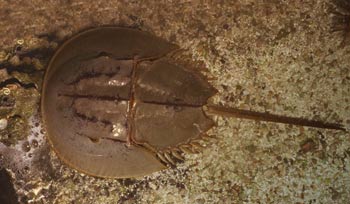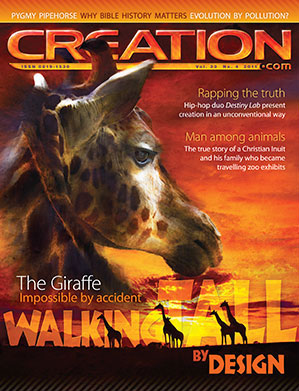Evolutionists can’t dodge ‘Living Fossils’

Modern Horseshoe Crab, Limulus polyphemus, World Aquarium, Missouri, USA

Dinosaur-Era (Jurassic) Horseshoe Crab, Mesolimulus walchi, Jura Museum, Germany
Despite the clear similarity of these horseshoe crabs, evolutionists insist on giving the fossil different genus and species names to its living counterpart. But where’s the difference? Note that the fossil specimen was found in rock labelled as “Jurassic”—said to date from 180–225 million years ago. Why is there no evolution (‘change’) in all that (supposed) time?
Some folk just don’t see the significance of the myriad examples of ‘living fossils’. Following our interview with Dr Carl Werner on the topic,1 one evolutionist protested:
“There is no written rule that says a lineage has to die out just because an offspring develops a beneficial mutation. The theory of evolution explains how species change over time, it doesn’t say that all species must change over time. As long as a species can survive in its environment and pass on its genetic information to its offspring, it can survive indefinitely. It doesn’t mean that the ‘living fossil’ didn’t speciate, it just means those possible splits died out while the original lineage was able to always successfully reproduce even into today. How exactly does that not work with evolution?”
However, as Dr Werner said in the article:
“If a scientist believes in evolution and sees fossils that look like modern organisms at the dinosaur digs, he/she might invent an hypothesis to ‘explain’ living fossils this way: ‘Yes I believe that animals have changed greatly over time (evolution), but some animals and plants were so well adapted to the environment that they did not need to change. So I am not bothered at all by living fossils.’ This added hypothesis says that some animals did not evolve. But if a theory can be so flexible, adding hypotheses that predict the opposite of your main theory, one could never disprove the theory. The theory then becomes unsinkable, and an unsinkable theory is not science.”1
Furthermore, some evolutionists have admitted that living fossils (‘stasis’) are a big problem for evolution.2 They have no explanation. This is not about suggesting that something has to go extinct if something evolves from it; that is not the point. The point is the lack of change, which is a huge problem for evolution, which is about vast changes. As high-profile evolutionists Stephen Jay Gould and Niles Eldredge admitted, “the maintenance of stability within species must be considered as a major evolutionary problem.”3
Evolutionists like to call it ‘evolutionary stasis’. But evolution is about change, and putting ‘evolutionary’ in front of ‘stasis’ does not explain stasis in terms of evolution.4 All organisms undergo mutations (accidental genetic changes). There is no mechanism that prevents mutations such that many organisms can remain the same for supposedly hundreds of millions of years.
And as if explaining the stasis exhibited by living ‘dino era’ creatures such as horseshoe crabs (pictured here) wasn’t already hard enough for evolutionists, what about far ‘older’ examples such as fossil ostracodes (clam-like arthropods known as ‘seed shrimps’), complete with exceptionally well-preserved soft body parts.5 With an evolutionary ‘age’ of 425 million years, the fossilized ostracodes look just the same as living ostracodes today.6 425 million years of stasis!? In that alleged time-frame, evolution by mutations and natural selection has supposedly changed some (unidentified) worm into all the species of fish, amphibians, reptiles, birds, and mammals (including elephants and mice, and of course, us). At the same time all the land plants have supposedly evolved. Such is the claimed power of evolution to change things, and yet these ostracodes have remained unchanged (and many others ‘dated’ even older).
In the evolutionary story, environmental change, or the development of new environmental niches, drives evolution as organisms adapt to new environments. So they argue that living fossils are the creatures whose environment did not change. However, in the evolutionary view Earth has sustained multiple global catastrophes (but not a global flood; the Bible speaks about that!) and multiple ice ages. How could there be any place on earth that has remained static, including no change in predators? And living fossils occur across the spectrum of life; and they are very common.
Combine the observations of stasis and the scarcity of transitional fossils (there should be millions of them) and you have to ask, “Where is the fossil evidence for evolution?”
Well-preserved fossils speak of rapid burial in water-borne sediment, consistent with the Bible’s account of the global Flood just 4,500 years ago. And stasis is right in line with the Creator having made creatures to reproduce “according to their kind”, just as Genesis says happened during Creation week, about 6,000 years ago. No millions of years. No evolution.
References and notes
- Living fossils: a powerful argument for creation—Don Batten interviews Dr Carl Werner, author of Living Fossils (Evolution: the Grand Experiment vol. 2), Creation 33(2):20–23, 2011. Return to text.
- See creation.com/living-fossils-enigma. Return to text.
- Gould, S. and Eldredge, N., Punctuated equilibrium comes of age, Nature 366(6452):223–224, 1993. Return to text.
- See: Bell, P., Evolutionary stasis: Double-speak and propaganda, Creation 28(2):38–40, 2006; creation.com/stasis. Return to text.
- Siveter, D., Sutton, M. and Briggs, D., An ostracode crustacean with soft parts from the Lower Silurian, Science 302(5651):1749–1751, 2003. Return to text.
- Oard, M., Remarkable stasis of a fossil ostracode with soft parts, Journal of Creation 18(3):16, 2004. Return to text.









Readers’ comments
Comments are automatically closed 14 days after publication.